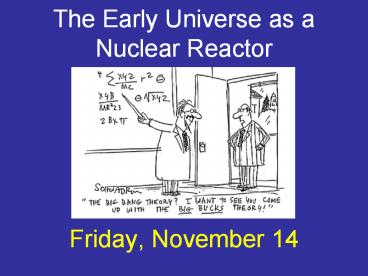The Early Universe as a Nuclear Reactor - PowerPoint PPT Presentation
Title:
The Early Universe as a Nuclear Reactor
Description:
The presence of helium (& a bit of lithium) in the early universe is the result of... Lithium-7 (7Li) has 3 protons, 4 neutrons ... – PowerPoint PPT presentation
Number of Views:41
Avg rating:3.0/5.0
Title: The Early Universe as a Nuclear Reactor
1
The Early Universe as a Nuclear Reactor
- Friday, November 14
2
Despite billions of years of fusion in stars,
most ordinary matter in the universe is still
hydrogen.
H 74 (by mass)
He 24
everything else 2
3
The Sun formed more than 9 billion years after
the Big Bang.
It contains some recycled material (gas
that had been inside earlier stars).
The first stars formed less than 750 million
years after the Big Bang, and contained no
recycled material.
4
Were the first stars made of 100 pure hydrogen?
We dont have to conjecture just look at
spectra of distant pristine gas clouds.
5
Result none of the early gas clouds are less
than 23 helium by mass.
When the first stars formed, they formed from gas
that already contained helium.
Where did this primordial helium come from?
6
Another result early gas clouds invariably
contain traces of lithium.
3 grams of lithium for every 10,000 tons of
hydrogen.
Where did this primordial lithium come from?
7
The presence of helium ( a bit of lithium) in
the early universe is the result of
Big Bang Nucleosynthesis (BBN) nuclear fusion
in the early universe (before the first stars)
Attaching a fancy label to a process doesnt mean
that we understand it!
8
BBN is as easy as 1 2 3
- Hydrogen (H) has 1 proton in its nucleus
- Helium (He) has 2 protons
- Lithium (Li) has 3 protons
9
BBN is as easy as 1 2 3
- Hydrogen-1 (1H) has 1 proton, 0
neutrons - Hydrogen-2 (2H, deuterium) has 1 proton, 1
neutron - Hydrogen-3 (3H, tritium) has 1 proton,
2 neutrons
(These are the three isotopes of hydrogen.)
10
BBN is as easy as 1 2 3
- Helium-3 (3He) has 2 protons, 1 neutron
- Helium-4 (4He) has 2 protons, 2 neutrons
- Lithium-7 (7Li) has 3 protons, 4 neutrons
(These are the two isotopes of helium,
the most common isotope of lithium.)
11
All atomic nuclei contain at least one proton.
All atomic nuclei heavier than Hydrogen-1 contain
at least one neutron.
There are plenty of free protons in the universe
today, but no free neutrons!
(Free unbound to any other particle.)
12
Why are neutrons held captive within atomic
nuclei?
Free neutrons are unstable against decay.
13
neutron
electron
n ? p e- ?
neutrino
proton
The half-life of a free neutron is 10 minutes.
Free neutrons can be produced by spontaneous
decay of heavy elements they just dont survive
long.
14
When the universe was much less than 10
minutes old, free neutrons would not have had
time to decay.
At t ltlt 10 minutes, the universe was a nearly
homogenous soup of particles, with about as many
neutrons as protons.
15
With both protons neutrons present, deuterium
(2H, heavy hydrogen) formed by fusion
proton
deuterium
p n ? 2H ?
neutron
photon
Aha! This is different from how deuterium is made
in stars!
16
In the early universe
p n ? 2H ?
In stars
p p ? 2H e ?
Okay, theres more than one way to make a
deuterium (2H) nucleus. So what?
17
In stars, two positively charged protons must be
brought together. This is difficult. Fusion is
slow.
(The Sun is 4.56 billion years old, and has
managed to fuse only half its hydrogen.)
In the early universe, a proton must be brought
together with a (neutral) neutron. This is easy.
Fusion is fast.
18
A stumbling block to making deuterium (2H) in the
early universe
The early universe was very hot, and thus
contained photons energetic enough to blast apart
deuterium.
2H ? ? p n
19
High-energy gamma-ray photons broke apart
deuterium as soon as it formed until the
universe was 3 minutes old.
Thats when the photons of the Cosmic Background
dropped too low in energy to bust up deuterium.
20
Three minutes after the Big Bang, the universe
was made safe for deuterium.
However, theres not a lot of deuterium in the
universe today. (Heavy water deuterium oxide
costs 2500 per gallon.)
21
Why the scarcity of deuterium? Because
nucleosynthesis continued
tritium
deuterium
2H n ? 3H ?
neutron
photon
However, tritium is even scarcer than deuterium
today.
22
Why the scarcity of tritium? Because
nucleosynthesis continued
tritium
helium
3H p ? 4He ?
proton
photon
Helium is common today.
23
Small amounts of stable lithium were made.
lithium
tritium
3H 4He ? 7Li ?
helium
photon
However, by this time (t 15 minutes) the
temperature dropped low enough that fusion ceased.
24
Big Bang Nucleosynthesis worked efficiently up to
helium-4, but not beyond.
(Elements heavier than helium were mostly made in
stars and supernovas.)
How much helium-4 do we expect from Big Bang
Nucleosynthesis?
25
Before BBN, there were about 2 neutrons for every
14 protons. (Some neutrons had already decayed.)
p
p
p
p
p
n
p
p
p
p
p
n
p
p
p
p
26
2 neutrons combine with 2 protons to form 1
stable helium nucleus, with 12 lonely protons
(hydrogen nuclei) left over.
helium nucleus
27
About 25 of the initial protons neutrons
(hence 25 of their mass) will be in helium the
rest will be hydrogen.
28
Early gas clouds are indeed about 25 helium by
mass, and about 75 hydrogen.
TRIUMPH FOR BIG BANG NUCLEOSYNTHESIS!
Theres just the amount of H He that
was predicted.
29
400,000 yr
3 min
750 million yr
nucleo-synthesis
trans- parency
1st stars galaxies
30
Mondays Lecture
The Hot Big Bang
Reading
Chapter 10

